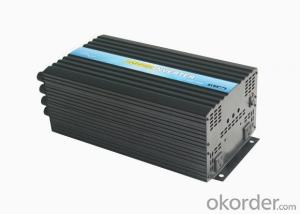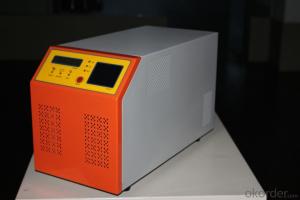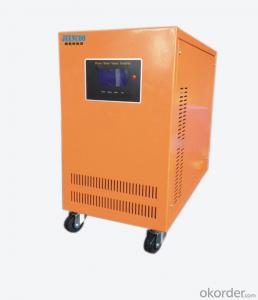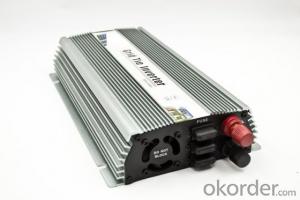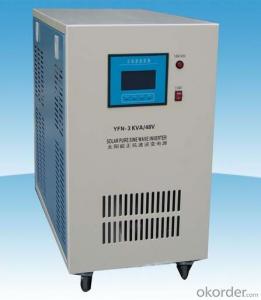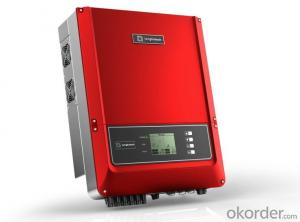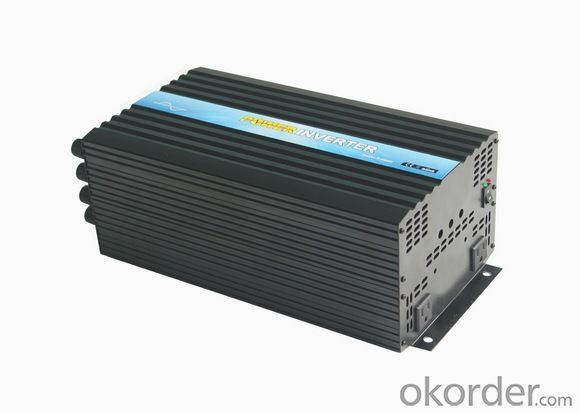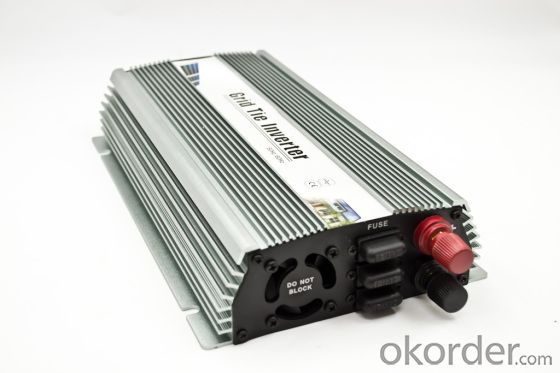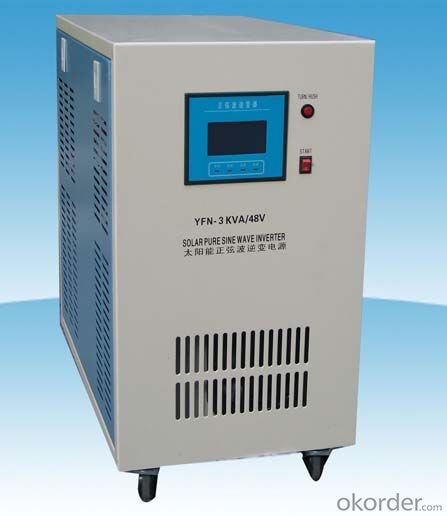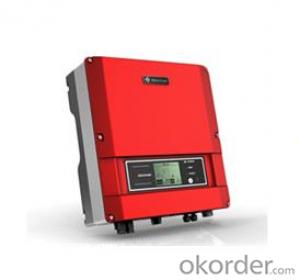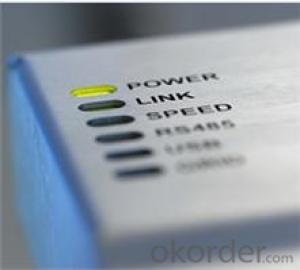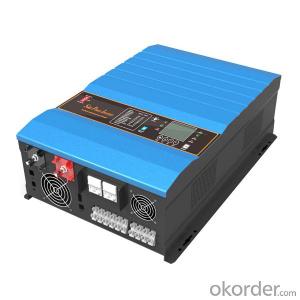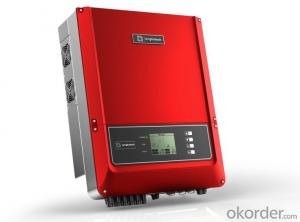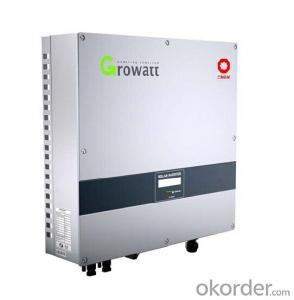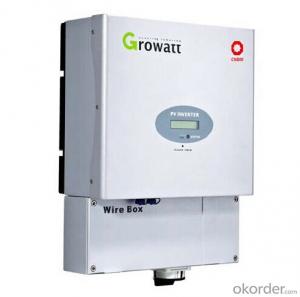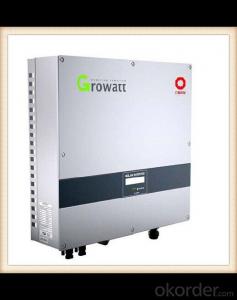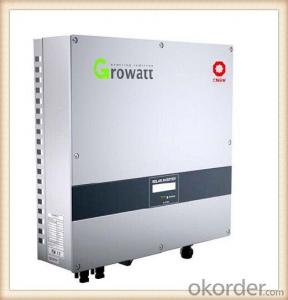Solar Inverter 230v CNBM-H 2KW Hybrid Inverter
- Loading Port:
- Shanghai
- Payment Terms:
- TT OR LC
- Min Order Qty:
- 1000 watt
- Supply Capability:
- 100000000 watt/month
OKorder Service Pledge
OKorder Financial Service
You Might Also Like
1.Description of the Solar Inverter
2KW hybrid inverter
Pure sine wave output
Microprocessor controlled to guarantee stable charging system
Multiple operations: Grid tie , Off grid , and grid tie with backup
Built-in MPPT solar charger
LCD display panel for comprehensive information
Multiple communication
Green substitution for generators
User adhustable charging current up to 25A
2.Data sheet of the Solar Inverter
| Model | CNBM-H 2KW |
| Rated Power | 2000W |
| Grid-tie operation | |
| PV Input(DC) | |
| Maximum DC power | 2250W |
| Nominal DC voltage / Maximum DC voltage | 300 VDC/350 VDC |
| Start voltage /Initial Feeding Voltage | 80 VDC/120 VDC |
| MPP voltage range | 150 VDC ~ 320 VDC |
| Number of MPP Trackers/ Max input current | 1/1 X15A |
| GRID OUTPUT (AC) | |
| Nominal Output Voltage | 101/110/120/127 VAC |
| Output Voltage Range | 88 - 127 VAC |
| Nominal Output Current | 30A |
| Power Factor | >0.99 |
| EFFICIENCY | |
| Maximum Conversion Efficiency (DC/AC) | 95% |
| European Efficiency@ Vnominal | 94% |
| OFF-GRID OPERATION | |
| AC INPUT | |
| AC Startup Voltage /Auto Restart Voltage | 60 - 70 VAC / 85 VAC |
| Acceptable Input Voltage Range | 85 - 130 VAC |
| Maximum AC Input Current | 30A |
| PV INPUT (DC) | |
| Maximum DC Voltage | 350 VAC |
| MPP Voltage Range | 150 VAC~320 VAC |
| Maximum Input Current | 1/1 X15A |
| BATTERY MODE OUTPUT (AC) | |
| Nominal Output Voltage | 101/110/120/127 VAC |
| Output Frequency | 50HZ/60HZ(auto sensing) |
| Output Waveform | Pure sine wave |
| Efficiency (DC to AC) | 90% |
| HYBRID OPERATION | |
| PV INPUT (DC) | |
| Nominal DC voltage / Maximum DC voltage | 300 VDC/ 350 VDC |
| Start voltage /Initial Feeding Voltage | 80 VDC /120VDC |
| MPP voltage range | 150VDC ~320VDC |
| Maximum Input Current | 1/1 X15A |
| GRID OUTPUT (AC) | |
| Nominal Output Voltage | 101/110/120/127 VAC |
| Output Voltage Range | 88 ~127 VAC |
| Nominal Output Current | 18A |
| AC INPUT | |
| AC Startup Voltage /Auto Restart Voltage | 60 - 70 VAC /85 VAC |
| Acceptable Input Voltage Range | 85 - 130 VAC |
| Maximum AC Input Current | 30A |
| BATTERY MODE OUTPUT (AC) | |
| Nominal Output Voltage | 101/110/120/127 VAC |
| Efficiency (DC to AC) | 90% |
| BATTERY & CHARGER | |
| Nominal DC Voltage | 48VDC |
| Maximum Charging Current | 25A |
| GENERAL | |
| PHYSICAL | |
Dimension, D X W X H (mm) | 420x415x170 |
| Net Weight (kgs) | 15.5 |
| INTRRF ACE | |
| Communication Port | RS-232/USB |
| Intelligent Slot | Optional SNMP ,Modbus, and AS400 cards available |
| COMPLIANCE | |
| Standard | CE, VDE, 0216-1-1, VDE-AR-N 4105 |
3.Applications of the Solar Inverter
Inverter not only has direct communication transform function, but also has the maximum limit to carry on the function of the solar cell function and system fault maintenance function. In the aggregate, have active operation and shutdown function, maximum power tracking control function, prevent operation function alone (grid system use), the active voltage adjustment functions (grid system use), dc testing functions (grid system use), dc grounding detection function (grid system use)
4.IMages of the Solar Inverter
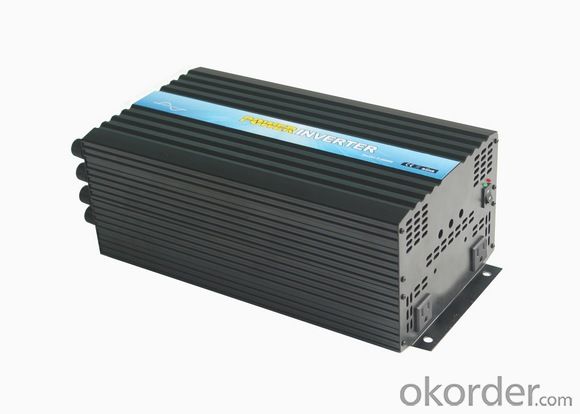
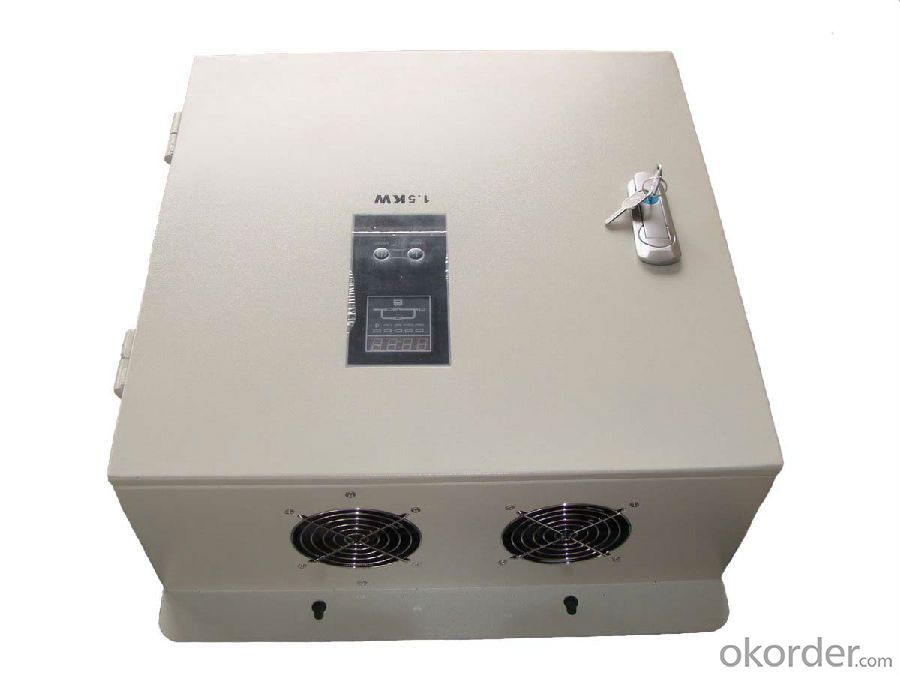
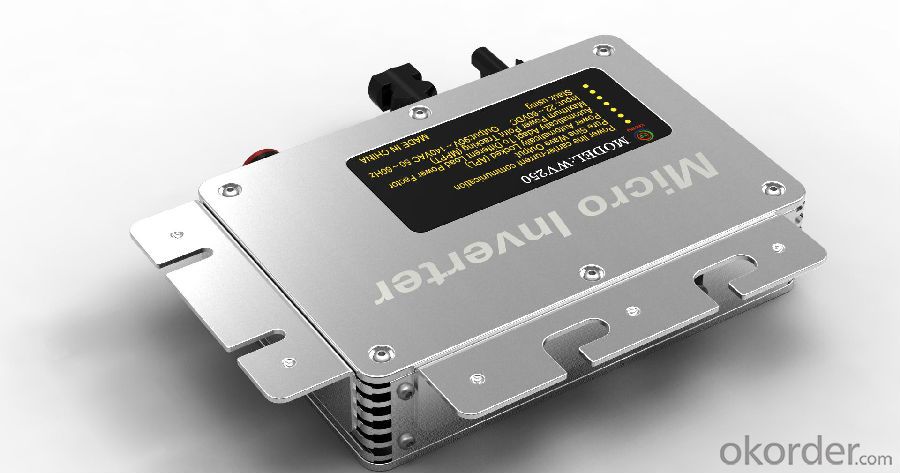
FAQ
Q: Do you have the CE, TUV, UL Certification?
A: We’ve already passed all the tests, and any certificate is available.
Q: Have you ever sold your products to companies in my country?
A: Of course, we have customers in all general PV markets, but I think we should expand our market share along with the market growth.
Q: When did your company set up? You are a new company, how can I believe your quality?
A: We entered into Solar PV industry in 2005, now we have several plants in manufacturing of a-Si and c-Si panels, and our capacity is 220MW per year. Till now we have already passed all the tests by authorized laboratories, e.g. TUV, CE, UL.
Q: Can you help us install the module if we cooperate with you?
A: We haven’t entered into installation sector, but we have the plan in near future.
Q: How do you pack your products?
A: We have rich experience on how to pack the panels to make sure the safety on shipment when it arrives at the destination.
Q: Can you do OEM for us?
A: Yes, we can.
Q: Can we visit your factory?
A: Surely, I will arrange the trip basing on your business schedule.
- Q: Can a solar inverter be used with a solar-powered educational system?
- Yes, a solar inverter can be used with a solar-powered educational system. A solar inverter is responsible for converting the direct current (DC) produced by solar panels into alternating current (AC) that can be used to power electrical devices. In the case of a solar-powered educational system, the solar inverter plays a crucial role in converting the DC energy generated by the solar panels to AC energy that can be utilized by the educational equipment, such as computers, projectors, or other electrical devices, thereby enabling the system to function efficiently.
- Q: What is the typical lifespan of the capacitors in a solar inverter?
- The typical lifespan of capacitors in a solar inverter can vary depending on various factors such as the quality of the capacitors, operating conditions, and maintenance practices. However, on average, capacitors in a solar inverter are expected to have a lifespan of around 10 to 15 years.
- Q: How does a solar inverter handle voltage and frequency variations caused by sudden load changes?
- Efficient and reliable, a solar inverter is specifically engineered to manage fluctuations in voltage and frequency resulting from sudden changes in load. When such changes occur, the solar inverter effectively employs a variety of control mechanisms to regulate and stabilize the output voltage and frequency. To begin with, the inverter continuously monitors the incoming solar power, keeping a close eye on the voltage and frequency. If any variations arise due to sudden load changes, the inverter promptly adjusts its internal control systems to compensate. Utilizing advanced power electronics and control algorithms, the inverter ensures that the voltage and frequency remain within the desired range. In order to handle voltage fluctuations caused by sudden load changes, the solar inverter utilizes a technique known as voltage regulation. It automatically adjusts the output voltage, either raising or lowering it as necessary. This guarantees that the inverter delivers a steady and consistent voltage supply to the load, effectively preventing any harm or malfunction. Similarly, to address frequency variations brought on by sudden load changes, the solar inverter employs a technique called frequency regulation. It adjusts the output frequency to match the grid frequency or meet specific frequency requirements. By maintaining the desired frequency, the inverter ensures compatibility and synchronization with the grid or other connected devices. In addition to voltage and frequency regulation, solar inverters also incorporate protective features to handle sudden load changes. They are equipped with built-in overload protection mechanisms capable of detecting excessive loads and preventing damage to both the inverter and the connected devices. These protective features may include safeguards such as overcurrent protection, short-circuit protection, and temperature monitoring. In summary, a solar inverter is purposefully designed to effectively manage voltage and frequency variations arising from sudden load changes. Through its voltage and frequency regulation capabilities, as well as its protective features, the inverter ensures stable and reliable operation. This enables the inverter to adapt efficiently to changing load conditions while safeguarding the integrity of the power supply.
- Q: Can a solar inverter be used in a solar-powered street lighting system?
- Yes, a solar inverter can be used in a solar-powered street lighting system. The solar inverter is responsible for converting the direct current (DC) power generated by the solar panels into alternating current (AC) power, which is required for the operation of street lights. Therefore, it plays a crucial role in ensuring the efficient and reliable functioning of a solar-powered street lighting system.
- Q: What is the role of a solar inverter in power factor correction?
- The role of a solar inverter in power factor correction is to adjust the power factor of the solar power system to ensure efficient energy conversion. It helps in balancing the reactive power and real power, leading to improved overall power quality and reduced system losses.
- Q: Can a solar inverter be used with solar-powered water heaters?
- No, a solar inverter cannot be used with solar-powered water heaters as they operate on different principles. Solar inverters are designed to convert the direct current (DC) generated by solar panels into alternating current (AC) for use in residential or commercial electrical systems. On the other hand, solar-powered water heaters use sunlight directly to heat water, without the need for converting DC to AC. Therefore, these two systems are not compatible with each other.
- Q: How does a solar inverter handle electromagnetic interference?
- A solar inverter handles electromagnetic interference by incorporating various filtering techniques and components to minimize the impact of electromagnetic interference on its operation. This includes using electromagnetic compatibility (EMC) filters, shielding, and proper grounding techniques. These measures help to reduce electromagnetic emissions from the inverter and also protect it from external electromagnetic disturbances, ensuring reliable and efficient operation.
- Q: How is the size of a solar inverter determined?
- The size of a solar inverter is typically determined by the total capacity of the solar panels it needs to handle. The inverter should have a capacity slightly higher than the total wattage of the solar panels to ensure efficient conversion of the DC power produced by the panels into usable AC power for household or grid consumption.
- Q: Can a solar inverter be used with different types of energy management systems?
- Yes, a solar inverter can be used with different types of energy management systems. Solar inverters are designed to convert the direct current (DC) produced by solar panels into alternating current (AC) that can be used in various electrical systems. They can be integrated with different energy management systems, such as battery storage systems, smart grids, or even hybrid systems that combine solar power with other renewable energy sources. This flexibility allows for efficient and optimized utilization of solar energy in different setups and applications.
- Q: How do you choose the right size of solar inverter for a system?
- When choosing the right size of solar inverter for a system, it is important to consider the total capacity of the solar panels and the expected power output. The inverter should have a capacity that matches or slightly exceeds the maximum power output of the panels to ensure optimal efficiency. Additional factors such as the type of grid connection and any future expansion plans should also be taken into account. Consulting with a professional solar installer or conducting a thorough system assessment can help determine the appropriate size of the inverter for a given solar system.
Send your message to us
Solar Inverter 230v CNBM-H 2KW Hybrid Inverter
- Loading Port:
- Shanghai
- Payment Terms:
- TT OR LC
- Min Order Qty:
- 1000 watt
- Supply Capability:
- 100000000 watt/month
OKorder Service Pledge
OKorder Financial Service
Similar products
Hot products
Hot Searches
Related keywords
